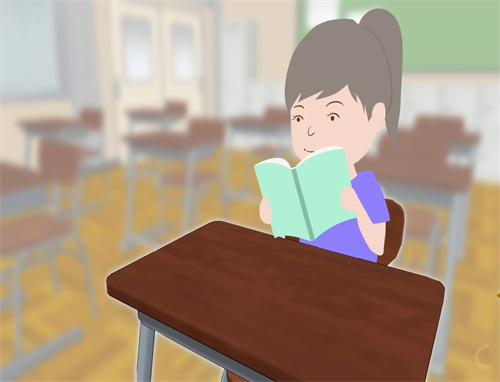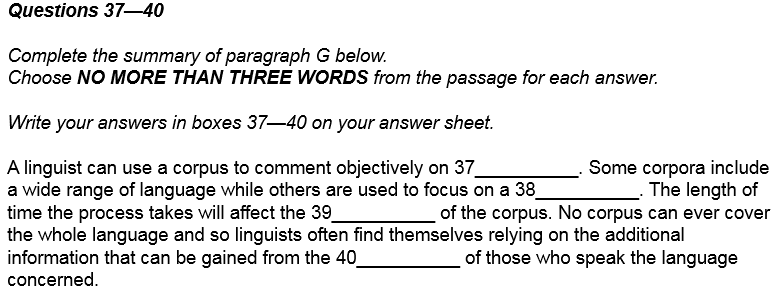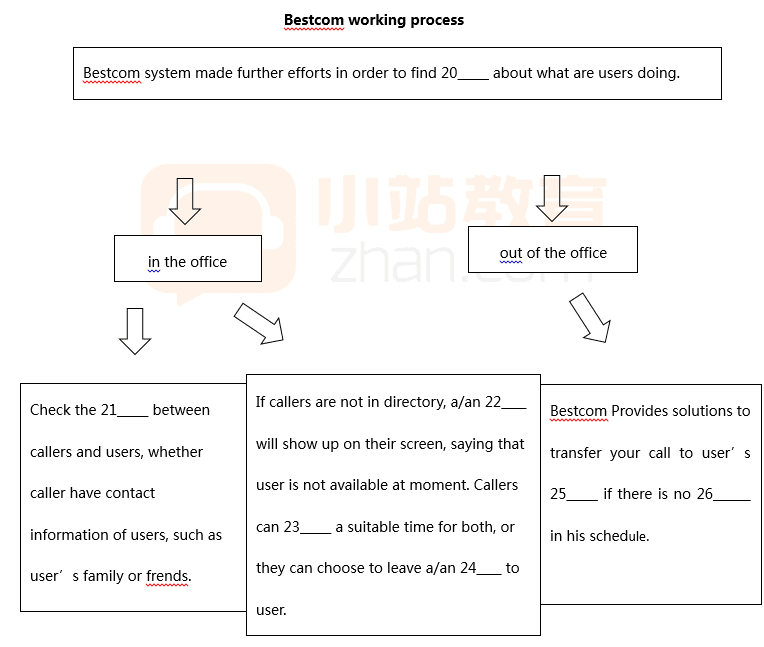雅思阅读14类题型解题技巧之Headings
有没有觉得阅读练习做很多,却没什么进步。下面小编给大家带来了雅思阅读14类题型解题技巧之Headings(找小标题),希望能够帮助到大家,下面小编就和大家分享,来欣赏一下吧。
雅思阅读14类题型解题技巧--Headings(找小标题)
Headings(找小标题)
1. 题型要求:文章由若干段话组成,要求给每段话找个小标题。
小标题即指该段话的段落大意,中心思想,主旨。本题型不是让你写出每段话的小标题,而是要求从选项列表(list of headings)中选择。
在现在的考试中,选项的数目往往大大多于文章中段落的数目,有很多干扰选项,假如文章有五段话,选项的数目很可能是十个,甚至十二个。
题目形式:通常会在文中一段话上标出小标题,然后要求为余下段落选择小标题。通常是原文的第一段。
在考试中,该题型A类每次必考一组,共5题左右。有时会考两组,共十题左右。G类不是每次必考,考的时候,一般只考一组,共五题左右。
2. 解题步骤
(1) 先将例子所在的选项从选项列表中划去,同时,不读例子所在的段落。
每个选项最多只能用一次,也就是说,两个段落的小标题不可能是一个选项。这是因为不同段落的主旨肯定是不同的,原文将他们分为不同的段落,就是要分别说不同的内容。
有时,这类题目的要求中有这样一句话:You may use any heading more than once(你可以使用任何小标题超过一次)。这句话纯属误导,也就是说,即使题目的要求中有这句话或类似的话,任何选项也不可能被使用两次以上。
既然每个选项最多只能用一次,所以例子所在的段落已经使用的选项是不会被其它段落使用的,将其划去,以免被其它的段落误选。而且在选其它段落的答案时,可以不看该选项,节省时间。
例子所在的段落已经给出了小标题,所以不必阅读该段落了,以免浪费时间,直接从下一段读起。
(2) 不要先看选项,而要从文章入手,读一段话,做一道题。
如果先看选项,不仅花费的时间很多,而且极易受到干扰选项的误导。所以先不要看选项,而是要先读文章。
读文章的时候,不要一下把文章全读完,而是读一段话,做一道题。假如原文的第一段已作为例子给出,那么,先读第二段,然后到选项列表中找该段话的小标题。然后再读第三段,同样处理,直至完成。这样做,不仅速度快,而且准确率高。
(3)读每段话时,要抓住该段话的主题句和核心词汇。正确答案常常是主题句的改写。
读每段话时,并不是该段落全要仔细阅读。这样,既浪费时间,也不容易抓住重点。应该抓住该段话的的主题句。
先读该段话的第一句,然后,与选项列表中大各选项一一对应,确定正确答案,正确选项一般就该句话的改写。如果答案不能确定,应再读该段话的第二句,然后,与选项列表中的各选项一一对应。如果答案还是不能确定,应再读该段话的最后一句,再与选项列表中大各选项一一对应。如果还是找不到正确答案,则就需要阅读整段话了。
根据统计,段落的主题句在第一句的可能性超过50%,段落的主题句在第二句的可能性超过20%,段落的主题句在最后一句的可能性超过20%。也就是说,按照上述方法做这种题型,读完该段话的第一句,就能在选项列表中找出该段话的Heading, 这种可能性超过50%。整段话都需要阅读的可能性不到10%。
(4) 某段话的答案确定后,将它的选项从选项列表中划去。
前面已经讲过,每个选项最多用一次,也就是说,不可能两个段落的小标题是一个选项。所以,一段话的答案确定后,将它的选项从选项列表中划去,以免被误选为其它段落的小标题。而且在选其它段落的答案时,可以不看选项,节省时间。但某段话的答案不太确定,如第三段可能是C,也可能不是C,这时不能将C从选项列表中划去。
NOTICE
(0)举例子的句子不会是主题句
(1)正确答案应是主题句的改写,所以与主题句特别一致的选项应引起怀疑。例:某段(1) 如果答案不确定,先将可能的选项全部选出。
(2) 干扰选项的特点是:段落中未展开说明的细节。
(3) 如果主题句比较复杂(如复合句),应重点看主句部分。主题句中,常常有如下的句式:Although/While/Despite/Despite the fact…, …的中文意思是:“虽然…,但是…”。前面是个让步状语从句,后面是主句,要说明的观点在主句中。
(4) 如果主题句中有show和suggest等词,应重点看其后的宾语从句。show和suggest是“表明”、“说明”的意思,其后的宾语从句往往是要说明的观点,是该段的主旨。
(5) 如果主句是not only…but also句型,应重点看but also后面的部分。not only…but also的意思是“不仅…而且…”,常用来承上启下。not only的后面是“承上”,即上一段主旨,but also 后面的部分是“启下”,即本段的主旨。所以重点看but also后面的部分。
(6) 问句不会是主题句问句通常作为引题,是过度性的句子。
(7) 如果需要阅读整个段落,应重点阅读该段落中的重点词句
A. 反复出现的词
B. 括号里的词
C. 引号里的词
D. 黑体字
E. 斜体字.
雅思阅读机经真题解析--Paul Nash
Paul Nash
APaul Nash, the elder son of William Nash and his first wife, Caroline Jackson, was born in London on 11th May, 1889. His father was a successful lawyer who became the Recorder of Abingdon. According to Ronald Blythe: "In 1901 the family returned to its native Buckinghamshire, where the garden of Wood Lane House at Iver Heath, and the countryside of the Chiltern hills, with its sculptural beeches and chalky contours, were early influences on the development of the three children. Their lives were overshadowed by their mother's mental illness and Nash himself was greatly helped by his nurse who, with some elderly neighbours, introduced him to the universe of plants."
BNash was educated at St. Paul's School and the Slade School of Art, where he met Dora Carrington. Unlike some of his contemporaries at the Slade School, Nash remained untouched by the two post-impressionist exhibitions organized by Roger Fry in 1910 and 1912. Instead, he was influenced by the work of William Blake. He also became a close friend of Gordon Bottomley, who took a keen interest in his career.
CNash had his first one-man show, of ink and wash drawings, at the Carfax Gallery in 1912. The following year he shared an exhibition at the Dorien Leigh Gallery with his brother, John Nash. Myfanwy Piper, has added: "Nash had a noteworthy sense of order and of the niceties of presentation; his pictures were beautifully framed, drawings mounted, his studio precisely and decoratively tidy, and oddments which he collected were worked up into compositions."
DPaul Nash was strongly attracted to Dora Carrington: He later recalled “Carrington was the dominating personality, I got an introduction to her and eventually won her regard by lending her my braces for a fancy-dress party. We were on the top of a bus and she wanted them then and there.”
EOn the outbreak Nash considered the possibility of joining the British Army. He told a friend: “I am not keen to rush off and be a soldier. The whole damnable war is too horrible of course and I am all against killing anybody, speaking off hand, but beside all that I believe both Jack and I might be more useful as ambulance and red cross men and to that end we are training. Nash enlisted in the Artists' Rifles. He told Gordon Bottomley: "I have joined the Artists' London Regiment of Territorials the old Corps which started with Rossetti, Leighton and Millais as members in 1860. Every man must do his bit in this horrible business so I have given up painting. There are many nice creatures in my company and I enjoy the burst of exercise - marching, drilling all day in the open air about the pleasant parts of Regents Park and Hampstead Heath."
FIn March 1917 he was sent to the Western Front. Nash, who took part in the offensive at Ypres, had reached the rank of lieutenant in the Hampshire Regiment by 1916. Whenever possible, Nash made sketches of life in the trenches. In May, 1917 he was invalided home after a non-military accident. While recuperating in London, Nash worked from his sketches to produce a series of war paintings. This work was well-received when exhibited later that year. As a result of this exhibition, Charles Masterman, head of the government's War Propaganda Bureau (WPB), and the advice of Edward Marsh and William Rothenstein, it was decided to recruit Nash as a war artist. In November 1917 in the immediate aftermath of the battle of Passchendaele Nash returned to France.
GNash was unhappy with his work as a member of War Propaganda Bureau. He wrote at the time: "I am no longer an artist. I am a messenger who will bring back word from the men who are fighting to those who want the war to go on forever. Feeble, inarticulate will be my message, but it will have a bitter truth and may it burn their lousy souls." However, as Myfanwy Piper has pointed out: "The drawings he made then, of shorn trees in ruined and flooded landscapes, were the works that made Nash's reputation. They were shown at the Leicester Galleries in 1918 together with his first efforts at oil painting, in which he was self-taught and quickly successful, though his drawings made in the field had more immediate public impact.
HIn 1919 Nash moved to Dymchurch in Kent, beginning his well-known series of pictures of the sea, the breakwaters, and the long wall that prevents the sea from flooding Romney Marsh. This included Winter Sea and Dymchurch Steps. Nash also painted the landscapes of the Chiltern Hills. In 1924 and 1928 he had successful exhibitions at the Leicester Galleries. Despite this popular acclaim in 1929 his work became more abstract. In 1933 Nash founded Unit One, the group of experimental painters, sculptors, and architects.
IDuring the Second World War Nash was employed by the Ministry of information and the Air Ministry and paintings produced by him during this period include the Battle of Britain and Totes Meer. His biographer, Myfanwy Piper, has argued: "This war disturbed Nash but did not change his art as the last one had. His style and his habits were formed, and in the new war he treated his new subjects as he had treated those he had been thinking about for so long. His late paintings, both oils and watercolours, are alternately brilliant and sombre in colour with the light of setting suns and rising moons spreading over wooded and hilly landscapes. 'Paul Nash died at 35 Boscombe Spa Road, Bournemouth, on 11th July 1946.
Questions 11-13
Answer the questions below.
Choose NO MORE THAN THREE WORDS AND/OR A NUMBER from the passage for each answer.
11 Because of a popular display of Nash's works created in the army, what did his
leader designate him as?
12 How did Nash learn oil painting?
13 What a change took place for Nash's painting style in the late second decade of
the twentieth century?
Questions 14-17
Choose the correct letter, A-G?
Write your answers in boxes 14-17 on your answer sheet.
What four statements are correct concerning Nash's story?
A He did not make an effort after becoming a high ranking official in the army.
B He had a dream since his childhood.
C He once temporarily ceased his painting career for some reason.
D He was not affected by certain shows attractive to his other peers.
E He had cooperation in art with his relative.
F Some of his paintings were presented in a chaotic way.
G His achievement after being enlisted in the army did not as much attention as his previous works.
Questions 18-23
The reading Passage has eleven paragraphs A-I.
Which paragraph contains the following information?
Write the correct letter A-I, in boxes 18-23 on your answer sheet.
NB You may use any letter more than once.
18 a charming lady in Nash's eyes
19 Nash's passion on following particularly appreciated artists
20 Nash's works with contrast elements
21 the true cause for Nash to join the military service
22 the noticeable impact on Nash's growth exerted from the rearing environment
23 high praise for Nash's unique taste of presenting his works
文章题目:画家 保罗﹒纳什
篇章结构
体裁
人物传记
题目
画家保罗﹒纳什
结构
(一句话概括每段大意)
A:保罗的出身介绍
B:保罗在求学期间的兴趣形成。
C:保罗举办个人画展及作者对于其画风的简评。
D:保罗的爱情故事。
E:参军使保罗暂时放弃绘画。
F:保罗因其战争画作初获认可,进而被招募为战争画家。
G:作为战争画家期间的作品使得保罗开始成名。
H:保罗开始创作山,水画作且风格变得抽象。
I:本文作者对于保罗画作的评论。
试题分析
Question 11-16
题目类型:客观事实题和判断对错题。
题号
定位词
文中对应点
题目解析
11
Display of Nash’s works, army, designate
F段,倒数第二句和第三句话。
此题类似于托福中的细节题,所以对应题目中的定位关键词即可找出正确答案。文中倒数第二句和第三句话直接解释了保罗为什么被招募为战争艺术家。
12
Oiling painting
G段倒数第一句话。
此题仍旧是客观性质的,文中直接描述了保罗是self-taught。
13
Painting style, the late second decade of the twentieth century
H段倒数第二句话。
此题与上述两题性质一样,文中直接给出了答案“his work became abstract”。
14
High ranking official, did not make an effort
F段第二句和第四句话。
第二句介绍了保罗在军队中的级别,第四句说“he was invalided home after a non-military accident”,据此所以选择A。
15
Ceased his painting career
E段倒数第二句话。
“every man must do his bit in this horrible business so I have given up painting”,据此所以选择C.
16
Not affected, certain show, other peeps
B段第二句话.
”unlike some of his contemporaries at…Nash remained untouched by the two post-impressions...”,据此所以选择D。
参考答案:
Version 17402主题山水画作家
14
A
15
C
16
D
17
E
18
D
19
B
20
I
21
E
22
A
23
C
24
A War Artist
25
Self-taught
26
More abstract
雅思阅读14类题型解题技巧之Headings相关文章:
★ 雅思阅读如何在1个月内有效提高
★ 雅思阅读题型解题小技巧
★ 雅思阅读找小标题类题型解题技巧
★ 雅思阅读主旨题技巧分享
★ 雅思阅读注意事项之把握阅读速度
★ 雅思a类阅读8种主要题型技巧总结
★ 如何提升雅思阅读整体做题速度
雅思阅读14类题型解题技巧之Headings
上一篇:雅思阅读多选题的正确解题步骤






